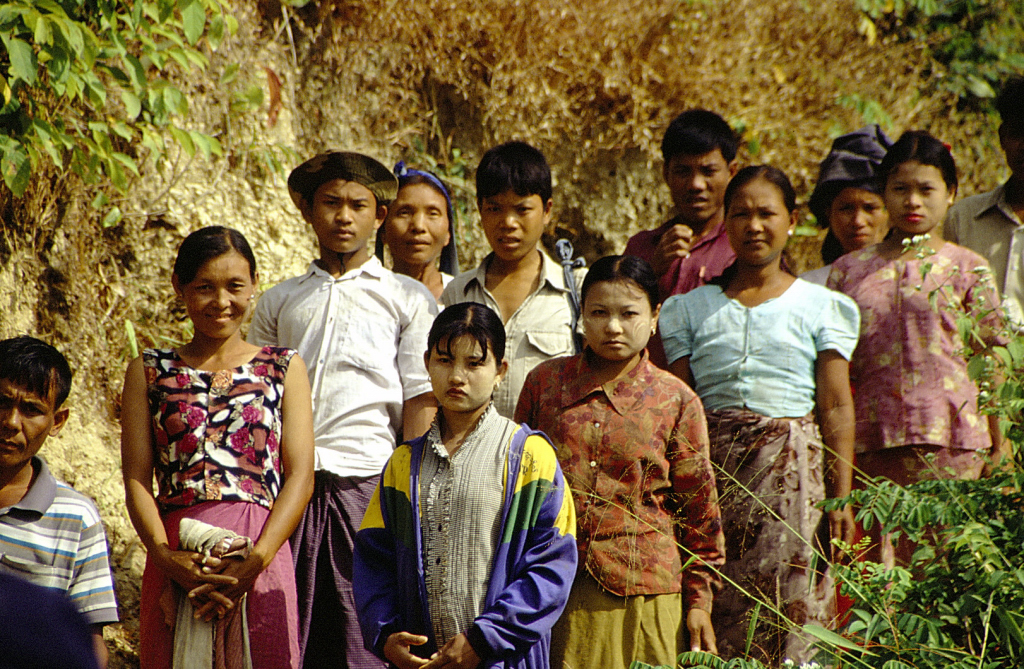Chin people(Part 1)
The Chin people (Burmese: ချင်းလူမျိုး; MLCTS: hkyang lu. myui:, pronounced [tɕɪ́ɰ̃ lù mjó]) are an ethnic group native to the Chin State of Myanmar, and India's northeast states. Strictly speaking, the term "Chin" only refers to the 53 sub-tribes of the Chin ethnic group, divided and recognized by the Burmese government. They speak the Kuki-Chin-Mizo languages, which are often mutually unintelligible but are closely related. The Chin are one of the founding groups of the Union of Burma, along with the Shan, Kachin, and Burmese. The Chin speak a variety of related languages, and share elements of culture and traditions.According to the British state media BBC News, "The Chin people... are one of the most persecuted minority groups in Burma." These people predominantly live in the Chin State, Bago Division, Ayeyarwady Division, Magwe Division, Rakhine State and Sagaing Region of Myanmar, but are also spread throughout Burma, Bangladesh and India. In the 2014 Burmese ethnic census, the Chin ethnicity was again dismissed[clarification needed] by the people of the Chin State. During the era of British rule, the colonial government used the compound term 'Chin-Kuki-Mizo' to group the Kukish language speaking people, and the Indian government inherited this nomenclature. Some Chin nationalists now consider that Chin would mean subtle Paite domination of Chin, Kuki and Chin identity, which other groups like Hmars, Chins (Chinmi), and Koms may not use. Etymology The term 'Chin' initially as used by the Burmese in Myanmar referred to all the hill tribes in the western frontier of Myanmar. However, in India the hill tribes are divided into two groups i.e. Chin-Kuki and Naga. The Kukis generally live to the south of the Nagas. The term now generally refer only to the majority Chin-Kuki-Mizo speaking communities of Myanmar since many of the similar tribes have rejected the name as foreign. Alternatively, the Chin-Kuki-Mizo use the original name of the people ‘Chinlung/Khul/Sinlung’. It goes by different pronunciations through the respective languages’ evolution to Yaw, Jou, Zou, Cho, Qin, Zy etc. History and politics The Chin people are believed to have come to Burma via the Chindwin Valley in the late ninth or tenth century A.D. They moved westward, and are thought to have settled in the present Chin State around 1300-1400. The Chin practice oral traditions and do not have written historical records The British first conquered Burma in 1824, established rule in 1886, and remained in power until Burma's independence in 1948. The 1896 'Pakokku Chin Hills Regulation Act' stated that the British would govern the Chins separately from the rest of Burma, which allowed for traditional Chin chiefs to remain in power while Britain was still allotted power via indirect rule (Human Rights Watch, 2009). Burma's independence from Britain in 1948 coincided with the Chin people adopting a democratic government rather than continuing its traditional rule of chiefs. The government did not allow the celebration Chin National Day. Instead of Chin National Day, Chin State Day is celebrated on February 20, the day that marked the transition from traditional to democratic rule in the Chin State (Center for Applied Linguistics, 2007). The newfound democracy of Chin State ended abruptly in 1962 with the onset of the military rule of General Ne Win in Burma (Center for Applied Linguistics, 2007). Ne Win remained in power until 1988, when nationwide protests against military rule erupted. These uprisings, commonly known as the 8888 because of the date on which they occurred, were met by an outburst of violence from the military government. The violent government response killed approximately 3,000 people in just a matter of weeks and imprisoned many more (Human Rights Watch, 2009). It was during this period of resistance to military rule that the Chin National Front (CNF) and its armed branch, the Chin National Army (CNA), gained momentum (Human Rights Watch, 2009). In 2012, the Chin National Army organized a ceasefire with the Burma military. In 2015, the Chin National Army (CNA) signed a National Ceasefire Agreement (NCA). Divisions Tribes There are many tribes among the Chin people, such as the Zomi, Lai, Zanniat, Yaw, Yindu, Senthang, Ngawn, Mizo, Zotung, Daai, Thadou (Kuki), Khami Mro-Khimi (Wakung), Matu, Hmar, Asho, Cho, Mara. The word "Chin" comes from “Chinlung”, which is believed to be a cave, where their ancestors once lived. A Chin scholar, Lian Uk in 1968, define the term “Chin” and similar names as “people”, further stating that the name “Chinland” means Ourland. Chin people are scattered between three countries, namely India, Burma (Myanmar) and Bangladesh. In India, the Chin people live in the state of Mizoram and a sizable population of Chin live in Churachandpur district of Manipur, consisting of smaller tribes such as the Hmar, Paite, and others. The Bawm tribe in southern Mizoram State and Bangladesh is a sub-group Lai tribe. Some of the Chin live in Rakhine State and most of them are Cumtu, Asho, Kongtu and Laitu. They are living in Myebon, Minbya, Ann, Thandwe and Gwa. Among them, the majority is Cumtu Chin. The Chin speak several languages, Kukish, Naga and Maraic languages; Ethnologue lists 49 languages in this group, of which 20 contain the word "Chin" in their name.Present-day ethnic groups Elderly Chin woman with facial tattoos in the Lemro River valley. There are several tribes within Chin people. For example: Cumtu, Zomi, The realization that the Zomi are one group that share common dialectical roots and customs despite separation by international and state boundaries, brought about movements for unification of the occupied territories and of the people. One of the first movements was the Mizo National Movement which ended with the formation of the Mizoram State in India. The re-unification of the Chin-Kuki-Mizo people in the Chin Hills, Manipur Hills, Biate Hills, Hmar Hills, Riam Hills, Rakhaing Hills, Lakher Hills, Yaw plains, Lushai Hill, Chindwin plains and the Chittagong Hill area arouse in 1990 with the Zomi Revolutionary Army. It is an armed group in Manipur, India.
